User Guide
Version: October 2024
Background
HIS SOCI assessment process
The process of conducting an HIS Stages of Continuous Improvement (SOCI) assessment is a highly collaborative and comprehensive endeavor which typically takes several weeks to complete. The assessment aims to evaluate and strengthen a country’s health information system (HIS) by assembling a group of experts to provide scores for the different HIS SOCI subcomponents and facilitating consensus building across all subcomponents of the five key domains. While the HIS SOCI website serves as a valuable tool for collecting and visualizing user inputs, it is important to note that the website is just one part of the overall assessment process.
In general, an HIS SOCI assessment begins with a government agency or another authority expressing interest in improving its HIS. The responsibility for conducting the assessment is then delegated to an organization or individual. Then the first step is to assemble a group of stakeholders with expertise in the five domains measured by the HIS SOCI assessment tool.
The process entails individual and collective assessments of the country’s HIS by gathering data on current status and future goals for each subcomponent within the domains. This data is then analyzed and consolidated to reach a consensus on the overall HIS stage of development. The assessment leadership team conducts stakeholder consultations, discusses findings, and works together to finalize the consensus scores for each subcomponent, domain, and the overall system.
To reinforce the consensus-building process, a multistep approach is encouraged. This approach involves assigning each domain to different groups to assess specific domains in detail, consolidating their findings in small groups, and seeking input from other groups in plenary sessions for general consensus building.
Throughout the assessment process, facilitators and participants should collaborate closely to ensure accuracy and alignment with the assessment’s objectives. An HIS SOCI assessment requires careful consideration, in-depth discussions, and strategic planning to generate meaningful results supported by strong evidence and a comprehensive improvement roadmap.
Given the complexities involved in assessing and strategizing improvements for an HIS, a typical HIS SOCI assessment may take several weeks to complete depending on the scope and scale of the evaluation. Effective communication, well-structured meetings, and efficient data sharing are crucial for the successful completion of the assessment.
Purpose of the User Guide
The purpose of this User Guide is to provide comprehensive guidance and support to users of the HIS SOCI Toolkit. This guide is designed to assist both Group Facilitators and Group Participants in effectively navigating and using the features and functionalities of the toolkit.
Specifically, this User Guide aims to:
- Provide step-by-step instructions for navigating the HIS SOCI Toolkit and understanding its features.
- Clarify the roles and responsibilities of Group Facilitators and Group Participants.
- Offer guidance on how to effectively gather, analyze, and interpret data during the HIS SOCI assessment.
- Facilitate collaboration and consensus-building among stakeholders to ensure accurate and meaningful results.
- Support the development of the Priority Roadmap and the drafting of the Assessment Report.
- Encourage best practices in the evaluation and continuous improvement of health information systems.
The User Guide empowers users to make the most of the HIS SOCI Toolkit, which will contribute to improved health information systems and better health outcomes. It encourages collaboration, data-driven decision making, and strategic planning for the continuous improvement of health information systems at national and organizational levels.
The Group Facilitator role
As the person responsible for guiding and overseeing the HIS SOCI assessment, the Group Facilitator’s responsibilities are diverse and instrumental in ensuring a successful and collaborative evaluation of the HIS.
Key responsibilities:
- Guide and oversee the HIS SOCI assessment process.
- Ensure collaboration and coordination among stakeholders.
- Lead discussions to reach consensus on scores for each domain.
- Facilitate data collection, analysis, and decision-making processes.
- Manage communication and maintain focus on the assessment objectives.
- Ensure accuracy in data interpretation and consensus-building.
- Finalize consensus scores for subcomponents, domains, and overall system.
- Submit the Consensus Assessment and Priority Roadmap forms.
- Guide the drafting of the Assessment Report based on results.
The Group Participant role
Group Participants are experts and stakeholders with domain-specific knowledge relevant to the HIS SOCI assessment. Their expertise contributes valuable insights and data to inform the overall evaluation process.
Key responsibilities:
- Provide domain-specific knowledge and expertise for the HIS SOCI assessment.
- Participate in discussions and contribute insights during the evaluation process.
- Assist in gathering data related to specific domains and subcomponents.
- Collaborate with other participants to reach consensus on domain assessments.
- Offer feedback during plenary sessions and contribute to general consensus building.
- Support evidence-based decision-making for improving the HIS.
- Help draft the Assessment Report based on their group’s findings.
Getting started with the HIS SOCI Tool
Welcome to the HIS SOCI Tool, a powerful platform designed to facilitate the assessment and improvement of health information systems. In this section, we will guide you through the initial steps to get started with the tool and explore its key features.
Reference to Screen: Landing/Home Page Layout

| Actions | Description | Destination |
| 1 | Primary navigation menu | Local navigation where visitors can find lower-level categories |
| 2 | User registration page link | Create new user account page |
| 3 | Login link | User login page |
Navigating the landing page
Upon visiting the HIS SOCI Tool website, you will arrive at the landing page, which serves as the entry point to the platform. The landing page offers a clear and intuitive layout, providing easy access to essential sections.
The primary navigation menu located at the top of the page offers the following categories.
Creating an account
To access the full range of features and participate in the HIS SOCI assessment process, you need to create a user account. Follow the steps below to set up your account.
Reference to Screen: Login/Create New Account/Reset Your Password Layout

| Actions | Description | Destination |
| 1 | Username input | |
| 2 | Password input | |
| 3 | Login button | Successful login will take user to My Dashboard page |
| 4 | Create new account link | User registration page |
| 5 | Reset your password link | Password reset page |
Walkthrough: Creating an account
| Step | Instructions |
| 1 | Click on the “User registration page link” on the landing page. |
| 2 | Fill in the required information, including your name, email address, and desired password. |
| 3 | Complete the registration process by clicking the “Register” button. |
Job aid: How to create an account
| Step | Instructions |
| 1 | On the landing page, click on the click on the user registration page link ("Create new account") to begin the account creation process. |
| 2 | Fill in the necessary information, including your full name, email address, and password. |
| 3 | Click the “Register” button to finalize the registration process. |
Logging in, password reset, and user dashboard access
If you already have a user account, logging in is easy using the following steps.
Walkthrough: Log in and reset password
| Step | Instructions |
| 1 | Click on the “Login link” at the top right corner of the landing page. |
| 2 | Enter your username (email address) and password. |
| 3 | Click the “Login” button to access your account and proceed to the user dashboard. |
Job aid: How to log in and reset password
| Step | Instructions |
| 1 | Click on the “Login link” located at the top right corner of the landing page to open the login page. |
| 2 | Provide your registered email address (username) and password in the designated fields. |
| 3 | Click “Login” to access your account. If you forget your password, click on the “Reset your password link” to initiate the password reset process. |
User dashboard overview
Once you log in, you will be directed to your user dashboard, which acts as the control center for your HIS SOCI assessment journey. The user dashboard offers a comprehensive overview of your assessments, activities, and progress.
Reference to Screen: User Dashboard Layout
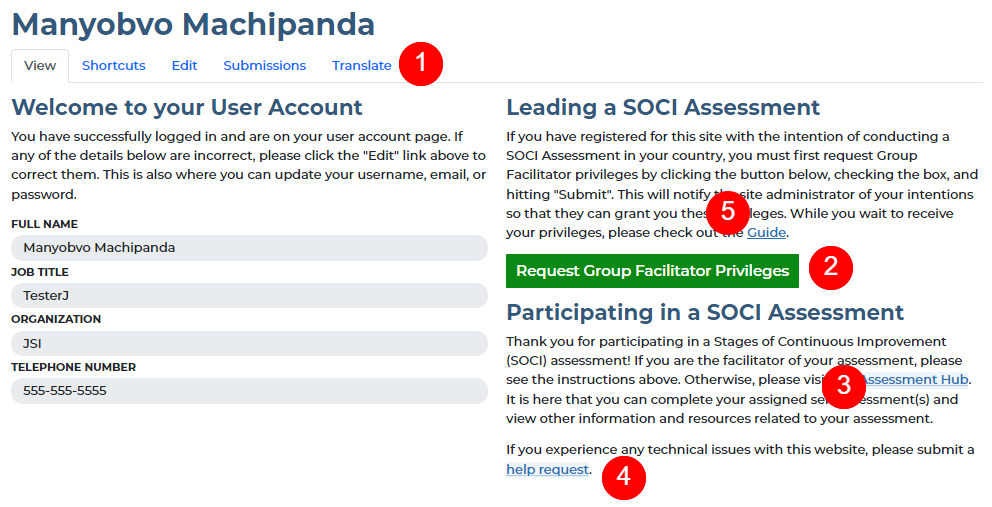
| Actions | Description | Destination |
| 1 | Profile edit links | Edit profile form |
| 2 | Request group facilitator privileges link | Request group facilitator privileges form |
| 3 | Assessment Hub link | Assessment Hub landing page |
| 4 | Help link | Submit help request form |
The user dashboard is divided into several sections, each serving a specific purpose.
The user dashboard serves as a central hub to navigate various components of the HIS SOCI Tool effectively. From here, you can access the Assessment Hub and easily start your assessments.
Assessment Hub
This page provides background information on your assessment and assessment team, including the country and HIS being assessed. You will find links to access the small group and consensus assessment, as well as tools to view, analyze, and report on your assessment data.
Reference to Screen: Assessment Hub Layout
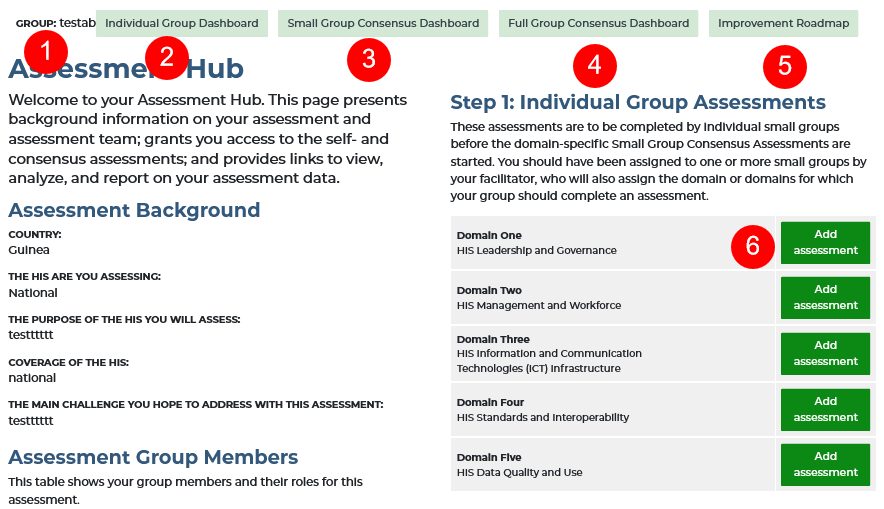
| Actions | Description | Destination |
| 1 | Group selector dropdown | Assessment Hub page for selected group |
| 2 | Individual group assessment results dashboard link | Individual group assessment results dashboard page |
| 3 | Small group consensus results dashboard link | Small group consensus results dashboard page |
| 4 | Full group assessment results dashboard link | Full group assessment results dashboard page |
| 5 | Improvement roadmap link | Improvement roadmap page |
| 6 | Add/Edit assessment link | Assessment form page |
Assessment background
In this section, you will find the background information related to the assessment you are conducting. This information will already be provided and includes the following details.
Review this section to gain an understanding of the context and objectives of the assessment before proceeding with the guided steps for the SOCI small group assessment.
Steps for a successful SOCI assessment
Here, we outline the key steps involved in a SOCI assessment.
Step 1: Individual group assessments
These assessments are to be completed by individual small groups before the domain-specific Small Group Consensus Assessments are started. An individual small group assessment is defined by either an individual or small group assessment. Your group facilitator will assign you specific domains to assess. For each domain, you will evaluate the current status, set future goals, and provide supporting evidence and comments to justify your assessments.
Step 2: Small Group Consensus Assessments
These assessments are to be completed by one Small Group Facilitator representing all of the groups who completed a given domain. As a group, you will complete the consensus assessment based on the scores and evidence provided in the individual group assessments (Step 1). This phase involves collaborative discussions and stakeholder consultations through a multi-step process to reach a collective consensus on final scores.
Step 3: Consensus Assessment
This form should be completed as a group based on the scores and evidence provided by the small group assessments. After completing the consensus assessment (Step 2), the next step is to create your improvement roadmap.
Step 4: Assembling your improvement roadmap
After completing the consensus assessment, the next step is to create your improvement roadmap. This involves adding improvement roadmap activities to address identified priorities. Refer to the Prioritization page to focus your efforts appropriately and set achievable goals.
Step 5: Assembling your report
Once your improvement roadmap is complete, the next task is to compile the assessment report. If you need support in completing the report, you can download and complete the Process Documentation Template file to send to CHISU. Alternatively, you can use the Assessment Report Template to prepare your assessment report.
Step 6: Submit your completed report
If you wish to have your finalized report included in the “Reports” page of this website for public access, please submit it using the provided link.
The Assessment Hub serves as your gateway to the various components of the SOCI assessment, allowing you to navigate through each step seamlessly and contribute effectively to the improvement of health information systems.
Step 1: Individual small group assessments
Conducting individual small groups assessments is a crucial step in the HIS SOCI assessment process, where individual participants evaluate the current status of their allocated HIS domains and subcomponents. This section will guide you through the process of completing small group assessments effectively.
Understanding the individual small group assessment
Individual small group assessment involves evaluating the current status of each HIS domain and its subcomponents based on specific criteria. You will be presented with questions related to the following aspects for each subcomponent. You should have been assigned to one or more small groups by your facilitator, who will also assign the domain or domains for which your group should complete an assessment.
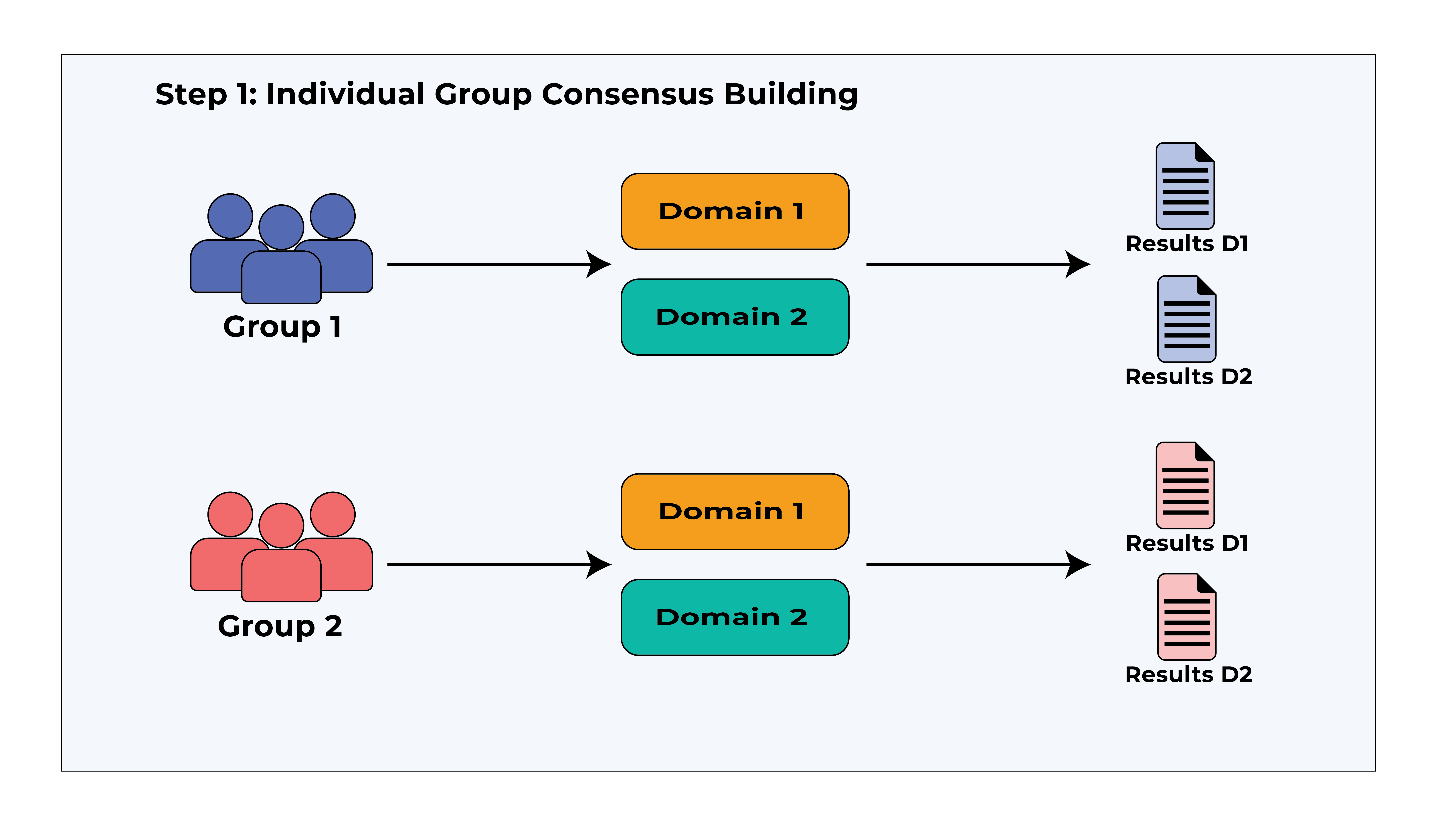
Accessing the individual small group assessment form
Reference to Screen: Assessment Hub Layout

To access the individual/small group assessment form, follow these steps:
Walkthrough: Accessing the assessment form
| Step | Instructions |
| 1 | Log in to your account on the SOCI website using your username and password. |
| 2 | Once logged in, you will be directed to your user dashboard. From there, click on the “Assessment Hub” link to access your Assessment Hub page. |
| 3 | In the Assessment Hub, you will see a list of the assessments assigned to you. Look for the specific assessment with the title or description that corresponds to the individual/small group assessment you need to complete. |
| 4 | Click on the link or button provided for the individual/small group assessment. This will take you to the small group assessment form for the respective HIS domain. |
Walkthrough: Completing the individual/small/full group assessment
To complete the individual/small group assessment for a specific HIS domain, follow these steps.
| Step | Instructions |
| 1 | Access the assessment form. Start by navigating to the Assessment Hub. From there, click on the specific HIS domain for which you want to complete the individual small group assessment. This will direct you to the assessment form for that domain. |
| 2 | Select “Current Status” and “Goal Status”. For each subcomponent within the selected domain, use the drop-down menu to choose the appropriate “Current Status” and “Goal Status” based on your assessment. |
| 3 | Provide supporting evidence. In the “Evidence Text” field, provide supporting information for the assessment. This could include a brief description or relevant hyperlinks that explain your chosen status. |
| 4 | Attach supporting documents. If applicable, you can attach supporting documents in the “Evidence Files” section to provide more context for your assessment. |
| 5 | Add comments or clarifications. If you have any additional comments or clarifications related to your assessment, you can enter them in the “Comments” field. |
| 6 | Save your progress. To save your progress and ensure that your entries are recorded, click the “Save” button located at the bottom of the small group assessment form. You can return to the form later to make further edits if needed. |
The individual small group assessments process is designed to collect individual assessments from participants before moving on to the small group consensus assessment, where you will collaborate with other participants to reach a consensus on the assessment scores and evidence. Ensure that you review your responses carefully before saving and submitting the individual small group assessments.
Setting future HIS goals
In the individual small group assessments process, setting future goals for each HIS subcomponent is a critical task. By envisioning the desired state of the HIS, you contribute to the development of the improvement roadmap. Follow the job aid provided to ensure that you accurately set meaningful future goals in your small group assessment.
Job aid: How to set future goals in the small/full group assessment
| Step | Instructions |
| 1 | Access the small group assessment form for the specific domain. |
| 2 | For each subcomponent, select the “Goal Status” option. |
| 3 | Specify the future goals or targets for each subcomponent. |
Saving and editing the small/full group assessment
During the small group assessment process, you have the flexibility to save your progress and return to edit your responses as needed. This allows you to review and refine your assessments before submission. Follow the job aid provided below to ensure that you successfully save and edit your small group assessment.
Job aid: How to save and edit the small group assessment
| Step | Instructions |
| 1 | Access the small group assessment form for the specific domain. |
| 2 | Complete the form by answering the questions for each subcomponent. |
| 3 | Click the “Save” button at the bottom of the form to save your progress. |
| 4 | To edit your responses, go to the Self-Assessment Results Dashboard and click on the specific domain’s small group assessment form. |
| 5 | Make the necessary edits and click “Save” again to update your progress. |
By following these instructions and using the provided job aids, you can confidently complete your small group assessments, contribute to the overall HIS SOCI assessment process, and facilitate the improvement of your HIS.
Step 2: Small Group Consensus Assessments
The Small Group Consensus Assessments are led by the Small Group Facilitator, who represents all the groups that completed assessments for a specific domain. This step builds on the individual small group assessments completed in Step 1 and aims to reach a collective agreement on the assessment scores and evidence submitted by each small group.
Reference to Screen: Assessment Hub Layout
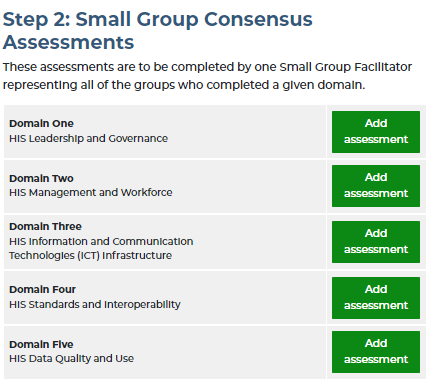
Role of the Small Group Facilitator
As the Small Group Facilitator, your role is to consolidate the inputs from multiple small group assessments and guide the team through a collaborative process to reach consensus. This involves reviewing the evidence, scores, and future goals submitted by each small group, discussing any discrepancies or areas of disagreement, and finalizing a unified assessment for the assigned domain.
Process Overview
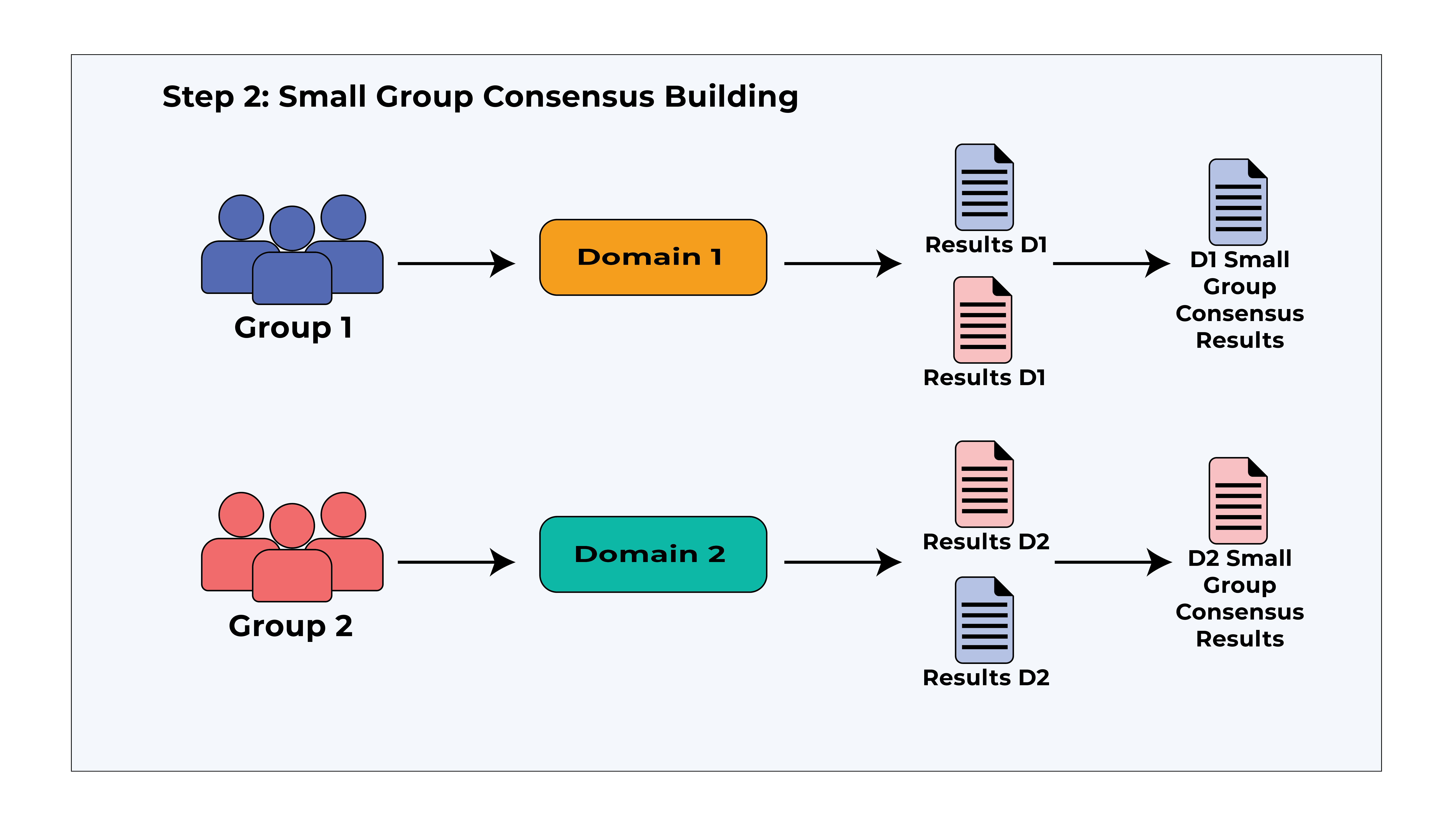
- Reviewing Individual Assessments: Begin by reviewing the individual small group assessments completed in Step 1. You will use the same platform to access these assessments via the Assessment Hub. The walkthrough for accessing the assessment form in Step 1 is applicable here as well, ensuring you can efficiently gather all relevant data from the different groups.
- Facilitating Discussion: Organize a discussion with all small group representatives to address any differences in the scores, supporting evidence, or future goals. Refer to the job aid on setting future goals from Step 1 if needed to ensure that clear, actionable targets are set during the discussion.
- Reaching Consensus: The objective is to achieve agreement on the “Current Status” and “Goal Status” for each subcomponent within the domain. Encourage participants to use the supporting evidence and comments they provided during their individual small group assessments. If needed, refer back to the process for saving and editing assessments from Step 1 to ensure everyone’s input is captured correctly before finalizing.
- Consolidating Evidence and Comments: As the facilitator, you are responsible for ensuring that the final consensus reflects a comprehensive and justified assessment. Use the same evidence attachment and comment fields referenced in Step 1 to upload additional supporting documents or comments that may have arisen during the consensus discussion.
Finalizing the Small Group Consensus Assessment
Once consensus is reached, the final scores, goals, and supporting evidence should be saved in the consensus assessment form. Follow the same job aid for saving and editing assessments from Step 1 to ensure that the group's work is securely saved and can be reviewed later if needed.
The small group consensus assessment forms the foundation for the next steps in the SOCI process, all groups consensus assessment, leading to the creation of an improvement roadmap and the final assessment report.
Step 3: Final consensus assessments for Group Participants
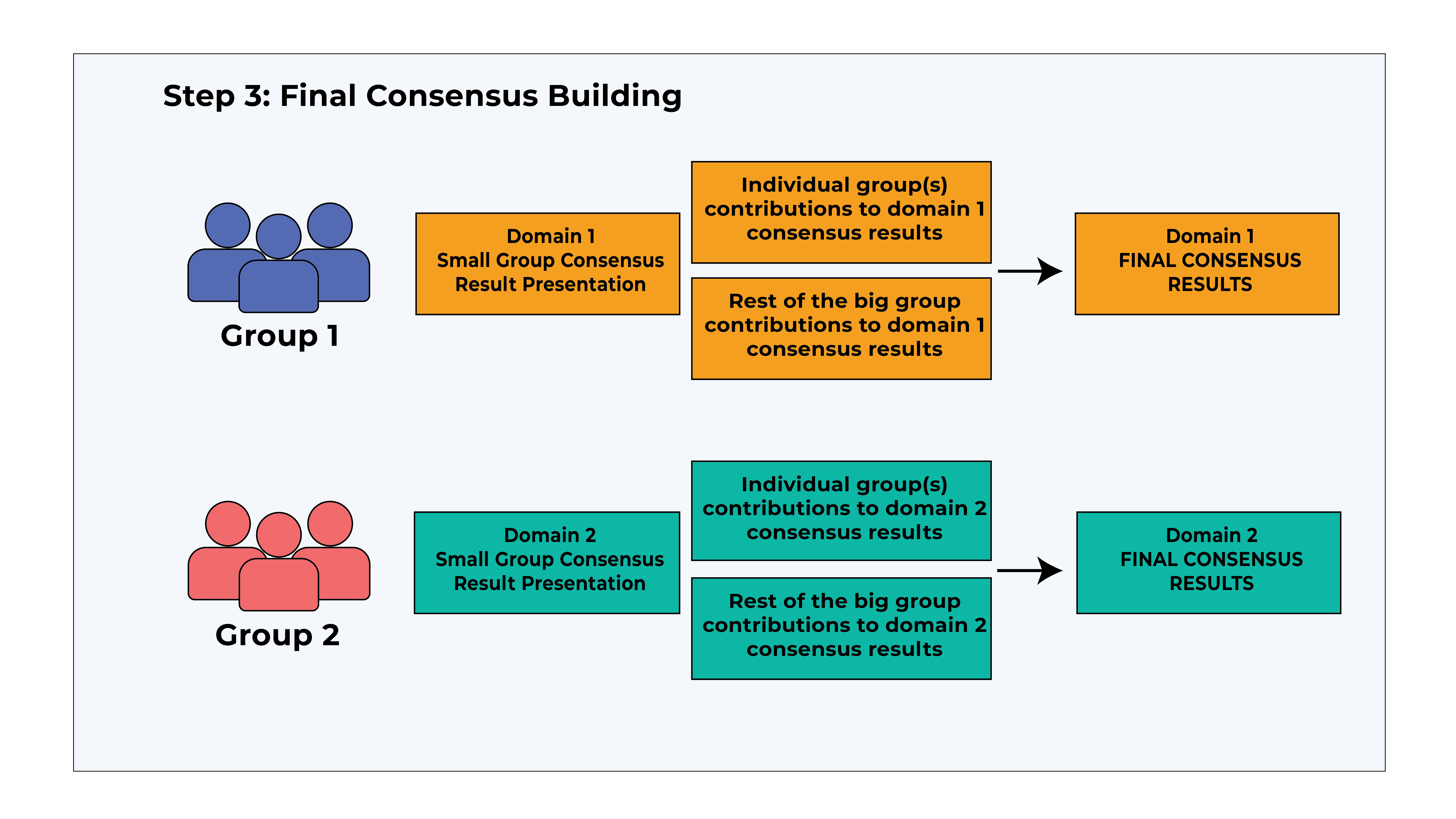
During the consensus assessment phase, you will collaborate with other participants, led by the Group Facilitator, to reach a consensus on the assessment scores and evidence for each subcomponent within the selected HIS domain. This phase builds on the small group assessments previously completed by small groups who completed a given domain. To reinforce the final consensus building, the group facilitators should encourage stakeholders to use a multi-step approach toward consensus building.
Reference to Screen: Step 2: Small Group Consensus Assessments (Assessment Hub Layout)

| Actions | Description | Destination |
| 1 | Add consensus assessment link/button | Consensus assessment form page for selected group |
Reference to Screen: Create Consensus Assessment Layout
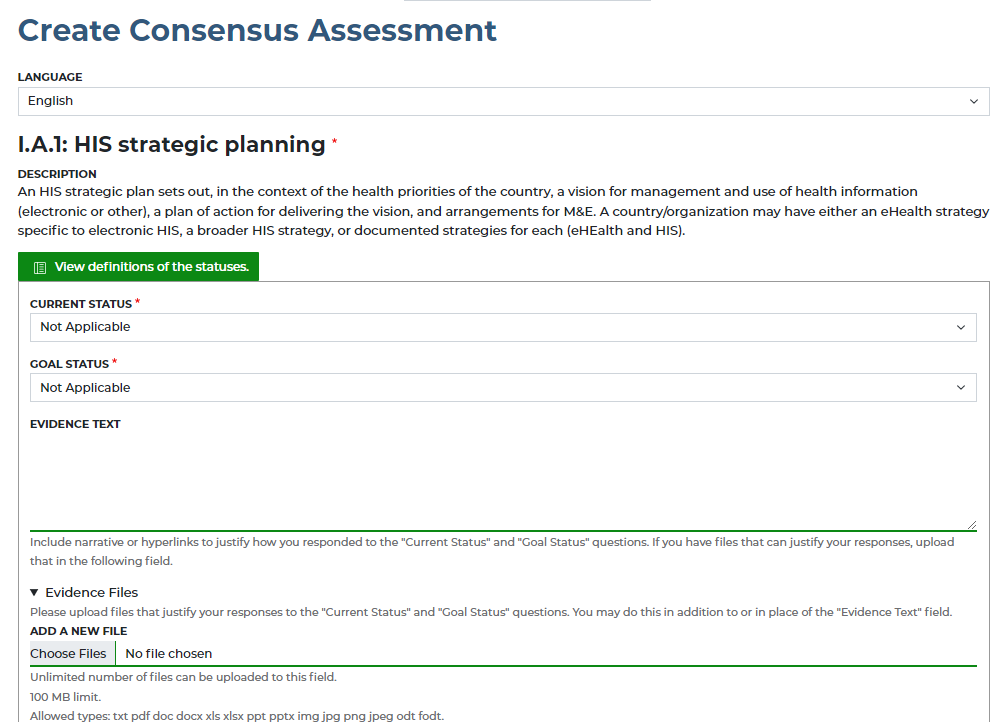
Facilitator’s role in consensus assessments
The Group Facilitator plays a crucial role in facilitating the consensus assessments. They will convene stakeholder consultations, either in-person or virtual, to discuss assessment findings and guide participants in reaching a consensus on the final scores for each subcomponent, domain, and the overall HIS stage of development. The Facilitator will ensure that all participants have the opportunity to provide their input during the consensus-building process (from small group consensus building to plenary consensus building).
Conducting consensus assessments
The following section is a walkthrough on how to actively participate in the consensus assessments.
Walkthrough: How to participate in the consensus assessments
| Step | Instructions |
| 1 | Access the consensus assessment form. The Group Facilitator will provide access to the consensus assessment form for the selected HIS domain. Participants will need to log in to their accounts to access the form. |
| 2 | Review small group assessment results. Familiarize yourself with the small group assessment results, including the chosen “Current Status” and “Goal Status” for each subcomponent. This will serve as the starting point for the consensus-building process. |
| 3 | Discuss and provide input. Start with small group consensus building and then move to a plenary session of final consensus building. During the stakeholder consultations, actively participate in discussions and provide your input on the assessment scores and evidence for each subcomponent. Engage in constructive conversations with other participants to build a consensus. |
| 4 | Resolve discrepancies. When there are discrepancies in assessment scores, work collaboratively with other participants to reach a consensus. Consider the evidence presented and aim to align assessment scores based on mutual understanding. |
| 5 | Finalize consensus assessment. After the stakeholder consultations, the Group Facilitator will summarize the consensus reached for each subcomponent, domain, and the overall HIS stage of development. Participants should review the finalized consensus assessment for accuracy and completeness. |
| 6 | Submit consensus assessment results. Once the consensus assessment is complete and reviewed, the Group Facilitator will submit the finalized results. Participants can access the results for their records and further analysis. |
Reaching consensus and resolving discrepancies
The process of reaching consensus in the consensus assessment phase involves open dialogue, active listening, and collaborative decision making. Participants are encouraged to provide evidence-based insights to support their perspectives. When there are discrepancies in assessment scores, constructive discussions are vital to arrive at a shared understanding and achieve a collective consensus.
Job aid: How to facilitate consensus and resolve discrepancies
Use the following table format to guide your participation in the consensus assessments.
| Step | Instructions |
| 1 | Familiarize yourself with the small group assessment results and chosen “Current Status” and “Goal Status” for each subcomponent. |
| 2 | Actively participate in stakeholder consultations to discuss and provide input on assessment scores and evidence. |
| 3 | If time allows, consider a multi-step process to build consensus in small groups. |
| 4 | In case of score discrepancies, engage in constructive conversations (within small groups) to resolve differences and achieve consensus. |
| 5 | Collaborate with other participants (assigned to other groups) to reach a larger consensus in plenary session on assessment scores by considering evidence and multiple perspectives. |
| 6 | In case of score discrepancies, engage in constructive conversations to resolve differences and achieve consensus. |
| 7 | Review the finalized consensus assessment for accuracy and completeness after the Group Facilitator summarizes the consensus reached. |
Submitting consensus assessment results
As a group participant, you do not need to directly submit the consensus assessment results. The Group Facilitator will handle the submission process once the consensus has been reached and the assessment is finalized. You can access the results for your reference and analysis on the HIS SOCI website.
Enhancing consensus and strengthening assessments through collaboration
To strengthen the consensus-building process, we highly recommend adopting a multi-step approach. Here’s how it works:
- Small group discussions: Start by assigning each domain to different small groups, where participants assess specific subcomponents in detail.
- Group consolidation: The findings from each small group are consolidated and discussed in small groups, allowing participants to review and align their scores.
- Plenary sessions: Each group presents their results to the broader group in plenary sessions for further input and final consensus building.
- Final consensus: The facilitator leads discussions to resolve any discrepancies, guiding the group to a final agreement on the assessment scores for each domain and the overall HIS development stage.
This multi-step, consensus-building approach has several benefits:
- Improved accuracy: Smaller groups can focus on specific domains, leading to more in-depth and accurate assessments.
- Collaborative input: Plenary sessions allow for broader participation and insight, strengthening the consensus process.
- Conflict resolution: The stepwise approach provides opportunities to address discrepancies in scores in a structured way, reducing conflicts.
- Stronger evidence base: By including multiple perspectives at different stages, this approach supports more robust, evidence-based conclusions.
- Enhanced stakeholder engagement: Multiple sessions encourage active participation from all stakeholders, promoting collaboration and buy-in.
- Comprehensive assessment: The method ensures that each domain is evaluated thoroughly, leading to a holistic and well-rounded HIS assessment.
By adopting this multi-step, consensus-building approach, the HIS SOCI assessment becomes a collaborative and inclusive process, leading to more informed decisions for improving health information systems.
Results dashboard
The results dashboard provides an overview of the assessment outcomes, presenting both small group assessment and consensus assessment results. It offers valuable insights into the current state of the HIS and the collective consensus reached by stakeholders. As a facilitator, understanding and effectively utilizing the results dashboard is essential for guiding participants in decision making and formulating improvement strategies.
Accessing small group assessment results
Reference to Screen: Self-Assessment Results Dashboard
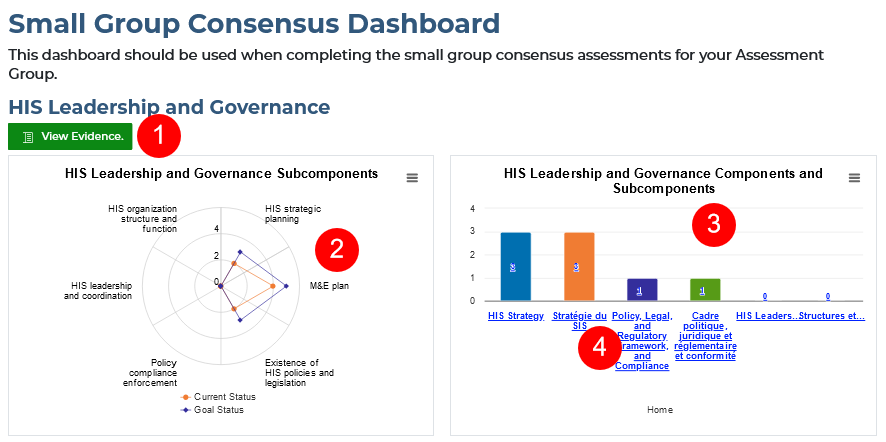
| Actions | Description | Destination |
| 1 | View evidence link | Assessment evidence used for the graph tab will appear (slide) on the right |
| 2 | Summary scores and goals for the assessment | |
| 3 | Domain graph with clickable subcomponents | Drill down of results from domain components to show subcomponents |
| 4 | Drill down for subcomponents results | Histogram for the selected subcomponent |
The small group assessment results dashboard displays individual small group assessment scores for each participant. It provides a comprehensive view of the strengths and weaknesses of the HIS, as identified by the participants during the small group assessment phase. Facilitators can use this dashboard to compare scores, identify trends, and gain insights into participants’ perspectives on different HIS domains.
The dashboard is organized into the following sections.
| Section | Description |
| Domain scores | Displays the average scores for each HIS domain, calculated based on the participants’ assessments. |
| Subcomponent scores | Shows individual scores for each subcomponent within the domains. |
| Future goals | Indicates the goals set by participants for each subcomponent and domain. |
| Comments | Contains participants’ comments and narratives supporting their scores and goal-setting decisions. |
As a facilitator, you can use the small group assessment results dashboard to identify areas of consensus or discrepancy and facilitate discussions during the consensus assessment phase.
Interpreting full group consensus assessment results
Reference to Screen: Consensus Assessment Results Dashboard
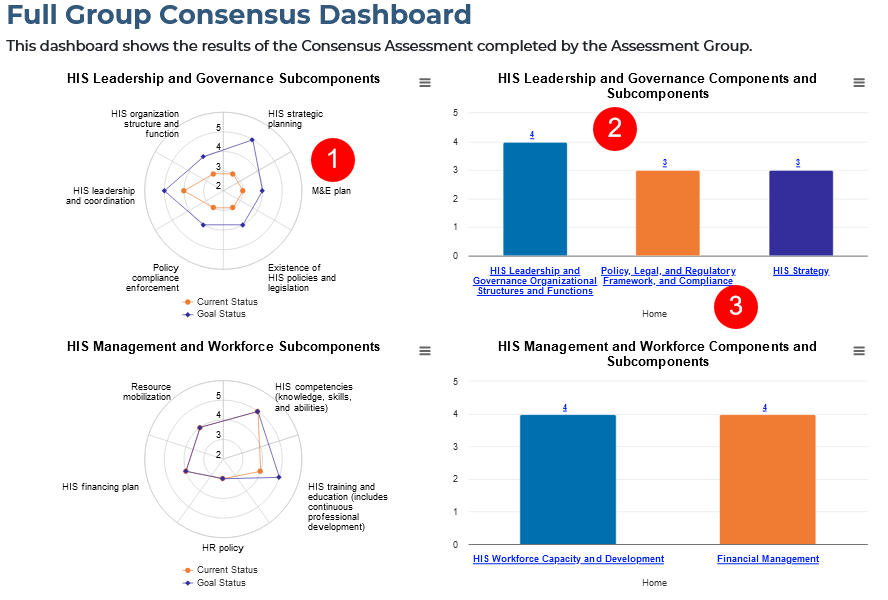
| Actions | Description | Destination |
| 1 | Summary scores and goals for the assessment | |
| 2 | Domain graph with clickable subcomponents | Drill down of results from domain components to show subcomponents |
| 3 | Drill down for subcomponents results | Histogram for the selected subcomponent |
The consensus assessment results dashboard presents the scores obtained after the stakeholder consultation and consensus-building process. This dashboard provides a unified view of the final scores agreed upon by the participants, reflecting collective decision making on the HIS status and future goals for domains, components, and subcomponents.
The dashboard includes the following components.
| Component | Description |
| Domain scores | Shows the final consensus scores for each HIS domain, representing the agreed-upon assessments. |
| Component scores | Shows the final consensus scores for each HIS component, representing the agreed-upon assessments. |
| Subcomponent scores | Displays the consensus scores for each subcomponent within the domains. |
| Future goals | Indicates the consensus on the future goals set for each subcomponent, component, and domain. |
| Comments | Contains comments and notes shared during the stakeholder consultation and consensus building. |
As a facilitator, the consensus assessment results dashboard helps you validate the final assessment outcomes and supports the development of improvement roadmaps and assessment reports based on collective agreement.
Walkthrough: Small/Full group assessment results dashboard
| Step | Instructions |
| 1 | Log in to the HIS SOCI Tool as a facilitator. |
| 2 | Access the facilitator dashboard. |
| 3 | Click on the desired “Results Dashboard” from the navigation menu. |
| 4 | E.g. Select “Small Group Assessment Results” or "Full Group Assessment Results" from the dashboard options. |
| 5 | Review the domain scores to understand the overall performance in each HIS domain. |
| 6 | Review the component scores to understand the overall performance in each HIS component. |
| 7 | Examine the Subcomponent Scores to identify specific strengths and weaknesses. |
| 8 | Note the Future Goals to understand participants' aspirations for each subcomponent, component and domain. |
| 9 | Check the comments section for additional context and narratives provided by participants. |
Job aid: Interpreting consensus assessment results
| Section | Explanation |
| Domain scores | Analyze the consensus scores for each HIS domain to determine the collective assessment outcome. |
| Component scores | Analyze the consensus scores for each HIS component to determine the collective assessment outcome. |
| Subcomponent scores | Review the consensus scores for each subcomponent to identify areas of agreement. |
| Future goals | Understand the consensus on future goals for each subcomponent and domain. |
| Comments | Consider any comments or notes shared during the consensus-building process for additional insights. |
Step 4: Creating improvement roadmaps and reports
In this section, as a group participant, you will play a crucial role in creating the improvement roadmap and compiling the assessment report. These steps are essential for translating the findings of the consensus assessment into actionable plans for strengthening the HIS.
Reference to Screen: Step 4: Improvement Roadmap (Assessment Hub) Layout

| Actions | Description | Destination |
| 1 | Improvement roadmap link/button | Improvement roadmap page for selected group |
Reference to Screen: Improvement Roadmap Layout

| Actions | Description | Destination |
| 1 | Add improvement roadmap activity link/button | Improvement roadmap activity form page |
| 2 | Edit roadmap activity link | Improvement roadmap activity form page |
| 3 | Delete roadmap activity link | Improvement roadmap activity deletion confirmation |
| 4 | Prioritization link | Identification, Prioritization and Planning of Solutions page |
Reference to Screen: Improvement Roadmap Activity Form Layout
Assembling your improvement roadmap
The improvement roadmap is a key outcome of the consensus assessment. It outlines the identified gaps and areas for improvement within the HIS. As a group participant, you will actively contribute to the creation of this roadmap. Follow the steps below.
Walkthrough: Assembling your improvement roadmap
| Step | Instructions |
| 1 | Review consensus assessment results. Access the consensus assessment results dashboard to familiarize yourself with the overall scores and findings from the assessment. |
| 2 | Prioritization. Before adding activities to the improvement roadmap, it is essential to prioritize them based on their significance and feasibility. Refer to the Prioritization page for guidance on how to prioritize the activities effectively (first, prioritize within the domain and prioritize across domains second). |
| 3 | Add improvement roadmap activities. Once the prioritization is complete, start adding improvement activities to the roadmap. Each activity should address specific gaps identified during the assessment. |
Job aid: How to create an improvement roadmap
For Group Participants:
We will break down the roadmap by domain to ensure focused and effective improvement planning. Please follow these steps to create your domain-specific improvement roadmap.
| Step | Instructions |
| 1 | Access the improvement roadmap section of the HIS SOCI online tool. |
| 2 | Find the improvement roadmap table related to your HIS domain. |
| 3 | After completing your consensus assessment, identify high-priority, achievable improvement activities for your domain. |
| 4 | Refer to the Prioritization page for guidance on prioritizing your activities effectively. |
| 5 | In the improvement roadmap table, include these columns for each improvement activity: Activity, Gap Addressed, Responsible Party, Necessary Resources, Means of Verification, and Deadline. |
| 6 | Enter the necessary details for each activity, specifying the responsible party, required resources, verification methods, and deadlines. |
| 7 | Set realistic deadlines for each activity, considering their priority and complexity. |
| 8 | Carefully review and refine your domain-specific Improvement Roadmap, ensuring clarity, feasibility, and alignment with your HIS domain’s needs and objectives. |
For Facilitators:
As a facilitator, you play a crucial role in capturing activities on the HIS SOCI online tool within the improvement roadmap section. Here’s how to guide your group participants effectively.
| Step | Instructions |
| 1 | Access the improvement roadmap section of the HIS SOCI online tool. |
| 2 | Ensure that the improvement roadmap is organized by HIS domains, as agreed upon. |
| 3 | Encourage group participants to add activities to their respective domain-specific improvement roadmaps. |
| 4 | Emphasize the importance of selecting high-priority, achievable activities that address identified gaps. |
| 5 | Suggest referring to the Prioritization page for guidance on prioritizing activities effectively. |
| 6 | Assist participants in completing the Improvement Roadmap table, ensuring that it includes columns for each improvement activity: Activity, Gap Addressed, Responsible Party, Necessary Resources, Means of Verification, and Deadline. |
| 7 | Encourage participants to provide detailed information for each activity, specifying responsible parties, resource requirements, verification methods, and deadlines. |
| 8 | Stress the significance of setting realistic deadlines for activities, considering their priority and complexity. |
| 9 | Review and validate domain-specific improvement roadmaps for clarity, feasibility, and alignment with HIS domain needs and objectives. |
Prioritizing HIS interventions and addressing gender integration gaps
To optimize the planning process, participants are encouraged to conduct prioritization in two steps. Firstly, prioritize the HIS interventions within each domain, and then prioritize them across all HIS domains.
The resulting scores will reveal the current status of the HIS and highlight the identified future goals. Use the measurement scale to identify gaps between the current and desired status, and outline specific steps to progress towards improved HIS performance.
When selecting interventions, it is crucial to distinguish between tasks and interventions. HIS interventions refer to a comprehensive package of activities aimed at addressing specific identified gaps and working towards the desired future goals.
Furthermore, the digital HIS SOCI tool automatically generates a gender analysis table with detailed scores for key subcomponents. It is essential to address gender integration gaps observed from the gender analysis table in your planning process.
By following this systematic approach, you can enhance the planning process, effectively prioritize interventions, and promote gender integration in the HIS.
Compiling your assessment report
As a group participant, with guidance from the facilitator, your active involvement is essential in compiling this significant report. Once you have completed the Improvement phase, the subsequent step is creating the assessment report. It is essential to produce a report documenting the process and experience of conducting the assessment and activities involved. If you wish to receive support from CHISU in completing the report, please download, complete, and send CHISU the Process Documentation Template file, following the instructions provided. Otherwise, you may use the Assessment Report Template to prepare and compile your assessment report.
Reference to Screen: Step 5: Assembling Report (Assessment Hub) Layout
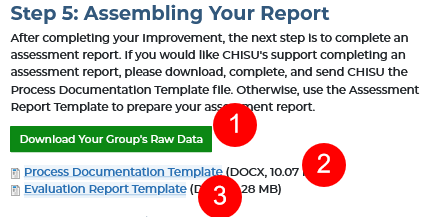
| Actions | Description | Destination |
| 1 | Download your group’s raw data link/button | Group raw data CSV file |
| 2 | Download Process Documentation Template link/button | Process documentation Word template |
| 3 | Download Assessment Report Template link/button | Group assessment report Word template |
Follow the steps below.
Walkthrough: Compiling your assessment report
| Step | Instructions |
| 1 | Review small group assessment and consensus assessment results. Familiarize yourself with the small group assessment and consensus assessment results to understand the scores and evidence provided. |
| 2 | Organize the report content. Collaborate with other group participants to organize the report content (see the provided assessment report template). |
| 3 | Compile the assessment report. Work with the group facilitator and other participants to compile the assessment report. Use the provided Assessment Report Template to structure the content effectively. |
Job aid: How to compile your assessment report
This job aid, tailored for a group participant, provides a clear, step-by-step guide for your role in compiling the assessment report effectively as part of the larger assessment team.
| Step | Instructions |
| 1 | Access the Assessment Report Template by downloading it from the provided link. |
| 2 | Familiarize yourself with the template structure and content to understand how to organize findings. |
| 3 | Fill in your group’s assigned sections, including assessment results and analysis. |
| 4 | Collaborate with your team to integrate findings and ensure consistency in reporting. |
| 5 | Provide a concise executive summary of the key assessment findings for your assigned sections. |
| 6 | Ensure that the assessment methodology is accurately represented in your assigned sections. |
| 7 | Use charts, graphs, and tables to present assessment results visually if applicable. |
| 8 | Analyze the assessment results and discuss their implications within your assigned sections. |
| 9 | Propose actionable recommendations based on the analysis and aligned with your assigned sections’ findings. |
| 10 | Review your sections meticulously for accuracy, clarity, and completeness. |
| 11 | Collaborate with your team to ensure a cohesive and coherent report. |
| 12 | Finalize your assigned sections of the report once you’re satisfied with content and structure. |
| 13 | Share your sections with the facilitator or report coordinator for integration into the final report. |
| 14 | Ensure your group’s assigned sections follow the established format and guidelines. |
Submitting your completed report
Once the assessment report is finalized, you may have the option to submit it for public access on the HIS SOCI website. If your group decides to share the report, follow the steps below.
Reference to Screen: Step 6: Submitting Report (Assessment Hub) Layout

| Actions | Description | Destination |
| 1 | Submit report link/button | Submit group report form page |
Reference to Screen: Submit Finalised Report (Assessment Hub) Layout
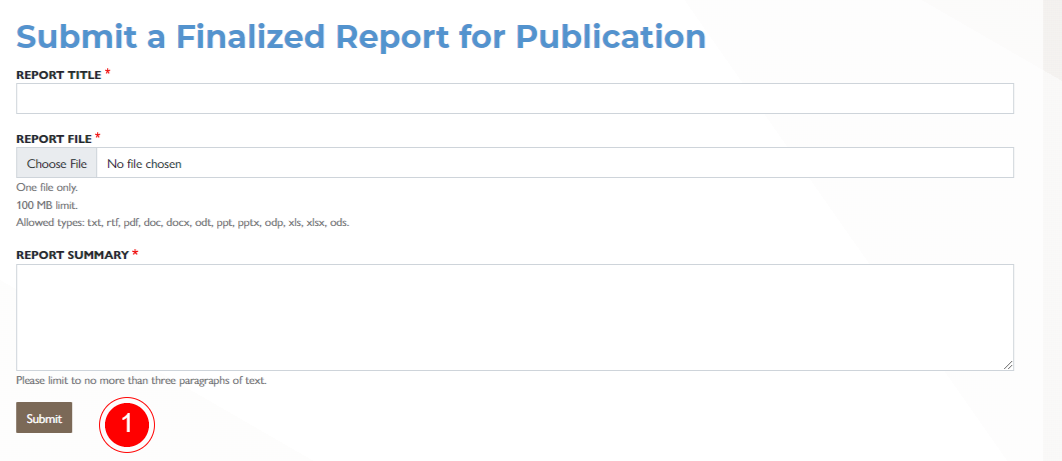
| Actions | Description | Destination |
| 1 | Submit link/button | Assessment Hub page |
Walkthrough: Submitting your completed report
| Step | Instructions |
| 1 | Access the Assessment Hub: Go to the Assessment Hub page and locate your group’s completed report form. |
| 2 | Submit the report: Click on the “Submit Report” link or button to initiate the submission process. |
Job aid: How to submit your assessment report
Refer to the provided job aid for detailed instructions on submitting your assessment report.
Your active participation in crafting the Improvement Roadmap and assessment report is crucial for enhancing health information systems and fostering evidence-based decision making within the health sector. Your valuable insights and collaborative efforts significantly shape the future of health information management, driving positive transformations for better health outcomes.
Conclusion
As a participant in the HIS SOCI assessment, you play a crucial role in contributing to the improvement of health information systems in your country or organization. Your insights, assessments, and consensus-building efforts are vital in shaping the future of healthcare data management and decision making.
Summary of participant’s role and key steps
Throughout the assessment process, participants are actively engaged in various steps, from conducting small group assessments to participating in the consensus-building phase. Here is a summary of your key responsibilities and the steps you have taken during the HIS SOCI assessment.
Your active involvement in the HIS SOCI assessment has significantly contributed to the generation of valuable insights and actionable recommendations for improving health information systems. The collective efforts of all participants are crucial in driving positive changes and advancing healthcare data management practices.
Walkthrough: Participant’s role and key steps
| Step | Instructions |
| 1 | Complete the assigned small group assessments for one or more HIS domains. |
| 2 | Assess the current status and set future goals for each subcomponent within the domains. |
| 3 | Provide supporting evidence and comments to justify your assessments. |
| 4 | Collaborate with other participants during the consensus assessment phase. |
| 5 | Engage in stakeholder consultations and discussions to reach consensus on final scores. |
| 6 | Ensure that the consensus reflects collective decision making. |
| 7 | Contribute to the creation of the improvement roadmap, focusing on identified priorities. |
| 8 | Use the Prioritization page to guide your goal-setting and intervention planning. |
| 9 | Distinguish between tasks and interventions to ensure a clear improvement plan. |
| 10 | Assist in compiling the assessment report, highlighting key findings and recommendations. |
| 11 | Ensure that the report reflects the collective consensus reached during the assessment. |
| 12 | Participate in group discussions and collaborative efforts to achieve consensus. |
| 13 | Share data and evidence to support assessments and decision making. |
Job aid: Participant’s role and responsibilities
| Section | Explanation |
| Self assessment | Participate in small group assessments, setting current status and future goals with supporting evidence. |
| Consensus assessment | Collaborate with others to reach collective consensus on assessment scores and goals. |
| Improvement roadmap | Contribute to the creation of the improvement roadmap, focusing on identified priorities. |
| Assessment report | Assist in compiling the assessment report, reflecting the collective consensus of stakeholders. |
| Collaboration | Engage in group discussions and data sharing to facilitate the consensus-building process. |
Facilitator Guide
Version October 2023
Background
HIS SOCI assessment process
The process of conducting an HIS Stages of Continuous Improvement (SOCI) assessment is a highly collaborative and comprehensive endeavor which typically takes several weeks to complete. The assessment aims to evaluate and strengthen a country’s health information system (HIS) by assembling a group of experts to provide scores for the different HIS SOCI subcomponents and facilitating consensus building across all subcomponents of the five key domains. While the HIS SOCI website serves as a valuable tool for collecting and visualizing user inputs, it is important to note that the website is just one part of the overall assessment process.
In general, an HIS SOCI assessment begins with a government agency or another authority expressing interest in improving its HIS. The responsibility for conducting the assessment is then delegated to an organization or individual. Then the first step is to assemble a group of stakeholders with expertise in the five domains measured by the HIS SOCI Assessment tool.
The process entails individual and collective assessments of the country’s HIS by gathering data on current status and future goals for each subcomponent within the domains. This data is then analyzed and consolidated to reach a consensus on the overall HIS stage of development. The assessment leadership team conducts stakeholder consultations, discusses findings, and works together to finalize the consensus scores for each subcomponent, domain, and the overall system.
To reinforce the consensus-building process, a multistep approach is encouraged. This approach involves assigning different groups to assess specific domains in detail, consolidating their findings in small groups, and seeking input from other groups in plenary sessions for general consensus building.
Throughout the assessment process, facilitators and participants should collaborate closely to ensure accuracy and alignment with the assessment's objectives. An HIS SOCI assessment requires careful consideration, in-depth discussions, and strategic planning to generate meaningful results supported by strong evidence and a comprehensive improvement roadmap.
Given the complexities involved in assessing and strategizing improvements for an HIS, a typical HIS SOCI assessment may take several weeks to complete, depending on the scope and scale of the evaluation. Effective communication, well-structured meetings, and efficient data sharing are crucial for the successful completion of the assessment.
Purpose of the Facilitator Guide
The purpose of this Facilitator Guide is to provide comprehensive guidance and support to group facilitators of the HIS SOCI Toolkit. This guide is designed to assist both Group Facilitators and Group Participants in effectively navigating and using the various features and functionalities of the toolkit.
Specifically, this Facilitator Guide aims to:
The Group Facilitator role
As the person responsible for guiding and overseeing the assessment, the Group Facilitator’s responsibilities are diverse and instrumental in ensuring a successful and collaborative evaluation of the HIS.
Key responsibilities:
Attributes of an effective Group Facilitator:
Accessing the facilitator dashboard
In the HIS SOCI Tool, both the user dashboard and the Assessment Hub function as the dashboard for Group Facilitators. These interfaces provide you with the necessary tools and features to effectively manage the HIS SOCI assessment process, facilitate collaboration among participants, and ensure the smooth progression of the assessment. Here’s how to access and navigate the facilitator dashboard:
Walkthrough: Accessing the facilitator dashboard
| Step | Action | Description |
| 1 | Log in | Use your login credentials to access your account. |
| 2 | Go to Assessment Hub | From your user dashboard, click on “Assessment Hub.” |
Reference to Screen: User Dashboard Layout
| Actions | Description | Destination |
| 1 | Profile edit link | Edit profile form |
| 2 | Request group facilitator privileges link | Request group facilitator privileges form |
| 3 | Assessment Hub link | Assessment Hub landing page |
| 4 | Help link | Submit help request form |
The user dashboard is divided into several sections, each serving a specific purpose.
Within the user dashboard and Assessment Hub (facilitator dashboard), you’ll find functionalities that allow you to create and manage assessment groups, assign participants to domains, oversee consensus building, and more. These interfaces are tailored to empower you as a Group Facilitator in guiding the assessment journey and promoting effective collaboration. Your role is crucial in facilitating consensus and ensuring the success of the HIS SOCI assessment, contributing to improved health information systems and informed decision making within the health sector.
Collaboration and data sharing
Collaboration and data sharing are essential components of the HIS SOCI assessment process. They enable stakeholders to work together toward strengthening health information systems effectively. In this section, we will explore how to effectively invite participants to the assessment group, manage group members and roles, and share assessment data with stakeholders.
Inviting participants to the assessment group
One of the key responsibilities of the Group Facilitator is to invite participants to the assessment group. This ensures that the right experts are involved in the assessment process. The provided job aid will guide you through the process of sending invitations to participants.
Job aid: How to invite participants to the assessment group
| Step | Instructions |
| 1 | Access the Assessment Hub and navigate to the “Manage Group Members” section. |
| 2 | Click on the “Add Group Member” button. |
| 3 | Fill in the required details of the participant to be invited. |
| 4 | Specify the role of the participant (Group Participant). |
| 5 | Send the invitation, either through the system-generated email or by creating a personalized email. |
| 6 | Wait for the participant to accept the invitation and join the assessment group. |
Managing assessment group members
As the Group Facilitator, it is essential to manage group members and their roles throughout the assessment process. The walkthrough below provides guidance on managing group members effectively.
Walkthrough: Managing group members and roles
| Step | Instructions |
| 1 | Access the Assessment Hub and go to the “Manage Group Members” section. |
| 2 | Review the list of group members and their assigned roles. |
| 3 | Add new members or remove members as needed, using the provided buttons. |
| 4 | Assign roles to new members (Group Participant) when adding them to the group. |
| 5 | Confirm that each member has the appropriate access and permissions to perform their tasks. |
Sharing assessment data with stakeholders
Sharing assessment data with relevant stakeholders is crucial for transparency and informed decision making. Use the job aid below to ensure secure and efficient data sharing.
Job aid: How to share assessment data
| Step | Instructions |
| 1 | Access the Assessment Hub and navigate to the “Assessment Reports” section. |
| 2 | Review the finalized assessment report and ensure it contains relevant and accurate data. |
| 3 | Determine the stakeholders with whom the data needs to be shared. |
| 4 | Choose the appropriate format for data sharing (e.g., PDF, link, or print). |
| 5 | Share the assessment report through the designated platform or directly with stakeholders. |
| 6 | Request feedback from stakeholders and address any inquiries or concerns. |
Collaborative data analysis and interpretation
Collaborative data analysis and interpretation are essential steps in the HIS SOCI assessment process. After completing the consensus assessment, the assessment leadership team (together with stakeholders) conducts a stakeholder consultation to discuss assessment findings and reach a consensus on final scores for each subcomponent, domain, and the overall HIS stage of development.
Walkthrough: Collaborative data analysis and interpretation
| Step | Instructions |
| 1 | Schedule a stakeholder consultation meeting with the assessment leadership team and relevant stakeholders. |
| 2 | Share the assessment data, including individual small group assessment results and consensus scores, with stakeholders. |
| 3 | Facilitate a discussion on the assessment findings, encouraging stakeholders to provide their input and perspectives. |
| 4 | Resolve any discrepancies in scores through consensus building and evidence-based discussions. |
| 5 | Finalize the consensus scores for each subcomponent, domain, and overall HIS stage. |
| 6 | Summarize the collaborative data analysis process and its outcomes for inclusion in the final assessment report. |
Dissemination of assessment results
Dissemination of assessment results is crucial for transparency, accountability, and decision making. The Group Facilitator, in collaboration with the assessment leadership team, should prepare and share the final assessment report with relevant stakeholders.
Job aid: How to disseminate assessment results
| Step | Instructions |
| 1 | Review the finalized assessment report to ensure accuracy and completeness. |
| 2 | Identify the key stakeholders and target audience for the assessment report. |
| 3 | Determine the most appropriate format for dissemination (e.g., digital PDF, printed report, or online publication). |
| 4 | Share the assessment report with stakeholders through appropriate channels (e.g., email, website, or presentation). |
| 5 | Encourage stakeholders to provide feedback and address any inquiries or concerns related to the assessment report. |
By effectively collaborating with participants, managing group members, sharing assessment data, and conducting collaborative data analysis, you can foster an environment of open communication and data-driven decision making throughout your HIS SOCI assessment process. Successful collaboration and data sharing contribute to the comprehensive and insightful evaluation of health information systems, leading to meaningful improvements and advancements.
Conducting and coordinating small group assessments
Conducting small group assessments is a pivotal phase in the assessment process. Facilitators play a crucial role in guiding participants through this phase to ensure accurate and insightful assessments.
Facilitating the small group assessment process
During this phase, participants delve into the small group assessment form to evaluate the HIS domains they are responsible for. As a facilitator, your guidance is pivotal in ensuring that participants navigate this process effectively and provide comprehensive insights.
Walkthrough: Facilitating small group assessment process
| Step | Instructions |
| 1 | Start by explaining the purpose and significance of small group assessments. |
| 2 | Assist participants in accessing the small group assessment form for their specific HIS domain from the small group assessment results dashboard. |
| 3 | For each subcomponent, guide participants to use the drop-down menu for selecting the appropriate “Current Status” and “Goal Status.” |
| 4 | Encourage participants to provide supporting information in the “Evidence Text” field. This could involve a brief description or relevant hyperlinks. |
| 5 | Instruct participants on how to attach supporting documents in the “Evidence Files” section if applicable. |
| 6 | Emphasize the importance of using the “Comments” field for any additional clarifications. |
| 7 | Remind participants to save their progress by clicking the “Save” button at the bottom of the form. |
Supporting participants in goal-setting
Goal-setting is a critical aspect of the small group assessment process, allowing participants to envision the desired future state of the HIS. Facilitators should guide participants in setting meaningful and achievable goals.
Job aid: How to support goal-setting in small group assessments
| Step | Instructions |
| 1 | Explain the significance of the small group assessment process as a key driver for improving the HIS. |
| 2 | Guide participants in accessing the small group assessment form, ensuring they select the appropriate HIS domain. |
| 3 | Provide clarity on the meanings of “Current Status” and “Goal Status” to ensure accurate selections. |
| 4 | Illustrate with examples the type of information that can be included in the “Evidence Text” field. |
| 5 | Demonstrate the process of attaching relevant documents for supporting evidence. |
| 6 | Encourage participants to use the “Comments” field to offer additional context to their assessments. |
| 7 | Stress the importance of saving their progress periodically to avoid data loss. |
| 8 | Address queries or concerns from participants, fostering a clear understanding of the assessment process. |
By effectively facilitating the small group assessment process and supporting participants in goal setting, facilitators contribute to the generation of accurate assessment data and meaningful future objectives for the HIS. This data becomes the foundation for further assessment steps, making the facilitator’s role instrumental in the success of the entire process.
Consensus assessments
Consensus assessments are a collaborative effort where the assessment group, under the guidance of the facilitator, comes to a mutual agreement on the scores for each HIS domain and subcomponent. This section will guide you through the process of conducting consensus assessments effectively.
Facilitator’s role in consensus assessments
As the Group Facilitator, your role during consensus assessments is crucial in guiding the assessment group to reach consensus on the scores for each HIS domain and subcomponent. Your responsibilities include:
Coordinating consensus assessments
Conducting consensus assessments involves bringing together all assessment group members to collectively finalize the scores based on the inputs from the individual small group assessments. Follow the provided walkthrough to facilitate consensus assessments smoothly.
Walkthrough: Facilitating consensus assessments
Reaching consensus and resolving discrepancies
The process of reaching consensus during consensus assessments involves the active involvement of all group participants. In cases where discrepancies in scoring arise, it is essential to facilitate constructive discussions and consensus building to arrive at mutual agreement on scores. Follow the job aid provided to effectively facilitate this process.
Job aid: How to facilitate consensus and resolve discrepancies
| Step | Instructions |
| 1 | Present the results from individual small group assessments to the group. |
| 2 | Encourage open discussions and justifications for assigned scores. |
| 3 | Identify any discrepancies in scoring among group members. |
| 4 | Facilitate discussions to resolve discrepancies and reach consensus. |
| 5 | Record the agreed-upon scores in the consensus assessment form. |
Submitting consensus assessment results
After the consensus assessment session, the Group Facilitator is responsible for submitting the final agreed-upon scores through the consensus assessment form. Once submitted, the assessment data will be compiled for further analysis and reporting.
By understanding the role of the Group Facilitator, conducting consensus assessments effectively, and following the provided job aids, you can ensure a successful and collaborative consensus-building process in the HIS SOCI assessment. This will lead to accurate assessments and ultimately contribute to improving your HIS.
Creating improvement roadmaps and reports
Creating improvement roadmaps and reports is a critical step in the HIS SOCI assessment process. It involves assembling the improvement roadmap, which outlines the actions needed to enhance your HIS, and compiling the assessment report, which summarizes the findings and recommendations. Follow the guidelines below to complete this stage effectively.
Assembling your improvement roadmap
The improvement roadmap is a comprehensive plan that identifies specific actions to be taken to enhance the HIS based on the assessment results. Use the provided job aid to create a clear and actionable improvement roadmap.
Job aid: How to create an improvement roadmap
| Step | Instructions |
| 1 | Refer to the prioritized assessment results from the consensus assessment. |
| 2 | Identify the highest priority HIS domains and subcomponents. |
| 3 | Define concrete actions (interventions) for each high-priority domain. |
| 4 | Set clear goals for each intervention, specifying the desired outcomes. |
| 5 | Ensure that the improvement roadmap is feasible, time-bound, and realistic. |
| 6 | Review and finalize the improvement roadmap with the assessment group. |
| 7 | Document the finalized improvement roadmap for implementation. |
Compiling your assessment report
The assessment report serves as a comprehensive document summarizing the HIS SOCI assessment process, findings, and recommendations. Use the provided job aid to compile a well-structured and informative assessment report.
Job aid: How to compile your assessment report
| Step | Instructions |
| 1 | Gather all the relevant data from the small group assessments and consensus assessments. |
| 2 | Create an executive summary that provides an overview of the assessment process and outcomes. |
| 3 | Include detailed descriptions of the assessment methodology and procedures. |
| 4 | Present the assessment results for each HIS domain and subcomponent. |
| 5 | Provide analysis and interpretation of the assessment findings. |
| 6 | Include the improvement roadmap with clear action plans and goals. |
| 7 | Add relevant visualizations, graphs, and tables to support the analysis. |
| 8 | Ensure the report is well-structured, coherent, and easy to navigate. |
| 9 | Review and edit the report for accuracy and clarity. |
| 10 | Share the draft report with the assessment group for feedback and approval. |
| 11 | Finalize the report based on feedback and submit it for review. |
Submitting your completed report
Once the assessment report is finalized, it is essential to share it with relevant stakeholders to inform decision making and promote transparency. Use the provided job aid to ensure a smooth and timely submission of your assessment report.
Job aid: How to submit your assessment report
| Step | Instructions |
| 1 | Review the finalized assessment report for accuracy and completeness. |
| 2 | Seek approval from the assessment group before submission. |
| 3 | Check the submission guidelines and requirements from the relevant authority or platform. |
| 4 | Submit the assessment report through the designated platform or to the appropriate authority. |
| 5 | Confirm the successful submission and verify that the report is accessible to the intended audience. |
By following the guidelines and job aids provided for creating improvement roadmaps and compiling assessment reports, you can ensure that your HIS SOCI assessment results are effectively communicated and used to improve your HIS.
Conclusion
As the facilitator, your role in the HIS SOCI assessment process culminates in the conclusion phase. This phase focuses on summarizing your involvement, acknowledging your impact, and ensuring ongoing support for continuous improvement.
Summary of facilitator’s role and key steps
In this section, you will reflect on your role throughout the assessment process and highlight the key steps you facilitated. This summary serves as a testament to your contribution and provides a comprehensive view of your responsibilities.
Walkthrough: Summary of facilitator’s role and key steps
| Step | Instructions |
| 1 | Reflect on your role as a facilitator, guiding participants through various assessment phases. |
| 2 | Summarize the key responsibilities you undertook, from creating assessment groups to supporting consensus building. |
| 3 | Emphasize the significance of your guidance in ensuring accurate assessments and fostering collaboration. |
| 4 | Highlight the accomplishments achieved through your facilitation, such as the compilation of assessment reports and improvement roadmaps. |
| 5 | Recognize the efforts of the participants and stakeholders who actively engaged in the assessment process under your guidance. |
Job aid: Summary of facilitator’s role and key steps
| Step | Instructions |
| 1 | Outline the scope of your role as a facilitator in the HIS SOCI assessment process. |
| 2 | List the key steps you facilitated, including creating assessment groups, guiding small group assessments, supporting consensus building, and encouraging collaboration. |
| 3 | Detail your role in promoting effective communication and engagement among participants and stakeholders. |
| 4 | Discuss the impact of your facilitation on generating accurate assessment data and fostering improvement initiatives. |
| 5 | Express gratitude to participants for their dedication and cooperation throughout the assessment journey. |
Continuing support for continuous improvement
The conclusion phase is not the end of your involvement. It marks the transition to a phase of ongoing support for continuous improvement. As a facilitator, your role extends beyond the assessment process to guide the implementation of improvement roadmaps, monitor progress, and sustain the momentum for positive change.
By providing continuous support, you ensure that the outcomes of the HIS SOCI assessment translate into meaningful enhancements in health information systems and evidence-based decision making.
In conclusion, your facilitation has played a pivotal role in shaping the future of health information management and fostering advancements in the health sector. Your commitment to guiding participants, promoting collaboration, and supporting improvement initiatives is an invaluable contribution to the growth and effectiveness of health information systems.